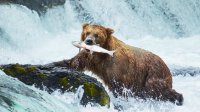How to Make Fat Bear Week Part of Your Classroom Activities
Giving students a peek into the lives of brown bears is a fun way to shake up science and math lessons and spark interest in animal conservation.
Your content has been saved!
Go to My Saved Content.Located on the Alaskan Peninsula just north of Kodiak Island, Alaska’s Katmai National Park and Preserve is known for its volcano-carved landscapes, miles of untouched wilderness, and the richest salmon runs in the country. It’s also home to a yearly celebration that allows people from across the globe to get up close and personal with some really, really fat bears.
Fat Bear Week is an annual event that was created by Katmai’s park rangers to help bring attention to this rich yet remote Alaskan ecosystem and its most well-known predator, the brown bear. During the fall, when salmon begin their runs in Alaska’s rivers, the state’s brown bears are preparing for their winter hibernation, an adaptation that helps them survive through the harsh winter months when there is no food to sustain them. To do this, they need to bulk up, and the perfectly timed salmon run is just what they need.
Since its inception in 2014, the event has become more and more popular, with a record 800,000 votes cast during last year’s Fat Bear contest. On the surface, it may appear to be little more than a silly distraction for folks longing for the return of March Madness. However, many teachers and educational organizations have quickly identified that Fat Bear Week can be used to engage students in valuable and authentic learning—all while still downloading your official bracket and voting for your favorite fat bear!
4 Ways to Incorporate the Event in Class Lessons
1. Observe bears through the Brooks Falls Live Cam. Hosted by Explore, this website has compiled live streams from animal cams across the country. On the Brooks Falls Live Cam, you’ll see a section of Katmai that is a well-known hot spot for bears.
Students can watch both live and highlight reels of Alaska’s famed brown bears catching the salmon that leap out of the water as they return to their spawning pools. If you’ve ever wanted to get students started with nature journaling, combining this live cam with the free lessons available on the website of naturalist John Muir Laws is a great way for students to develop observational and inquiry skills. If students have questions about what they’re seeing, they can also participate in several scheduled live chats on the Explore.org live chat channel.
2. Have students read the Bears of Brooks River 2022 guidebook. This nearly 100-page e-book contains a wealth of information about the lives and habits of Alaska’s bears, as well as detailed biographies of those that have been observed at Brooks Falls. The guide can be used to learn more about elementary science topics such as animal adaptations or inherited traits. This guide could also be used in English language arts lessons focused on Common Core State Standards related to information reading or identifying supporting evidence from a text.
3. Teach a lesson from the National Park Service website. The educational staff at Katmai have curated a huge number of lessons for students of all ages that can be found on their website.
Many topics that are core to the Next Generation Science Standards (NGSS) and other science frameworks are included in this curriculum. Highlights of this collection include having third graders create a food web of the Katmai ecosystem to learn more about the interdependence among the park’s animal species. Students in high school math can use data collected from Alaska’s Department of Fish and Game to investigate the health of salmon populations over time through graphs or equations.
4. Encourage students to earn their Junior Ranger badge. Due to Katmai’s remote location, students living anywhere have the opportunity to earn their Junior Ranger badge virtually by downloading, completing, and mailing in the official Junior Ranger workbook. The book includes information not just about bears; it also explores the history and culture of the park and southern Alaska.
Junior Ranger experiences don’t have to be relegated to the elementary grades alone. Katmai also has a way for older students and adults to earn a Not-So-Junior Ranger badge. The short booklet delves into additional disciplines, such as geology, history, and Earth science, expanding the possibilities for interdisciplinary connections or folding in other standards within the NGSS. A great activity for middle school students that can run concurrently with Fat Bear Week is for them to investigate how volcanic activity helped sculpt the Katmai area through videos and readings provided by the USGS and the National Park Service (Disciplinary Core Idea MS-ESS2-2).
In addition to Fat Bear Week, beginning October 5, this year there’s also a Fat Bear Junior event that began on September 29. This shorter event is a great way to introduce your students to the themes present in Fat Bear Week if you don’t have time for the main event. Make sure to check out the Katmai National Park’s official website to learn more about the special events taking place all week long.
